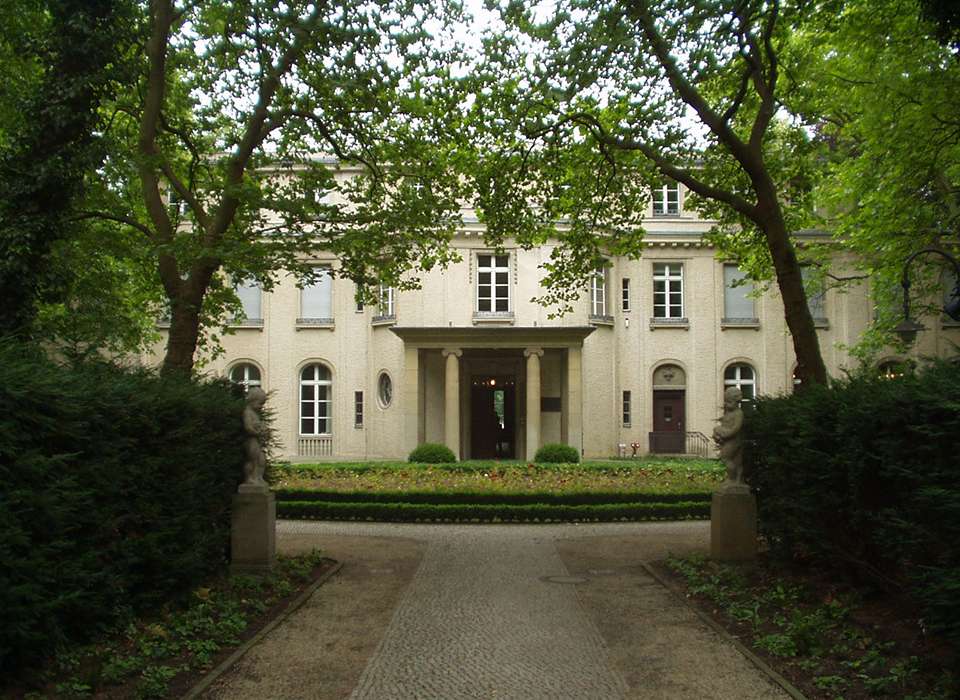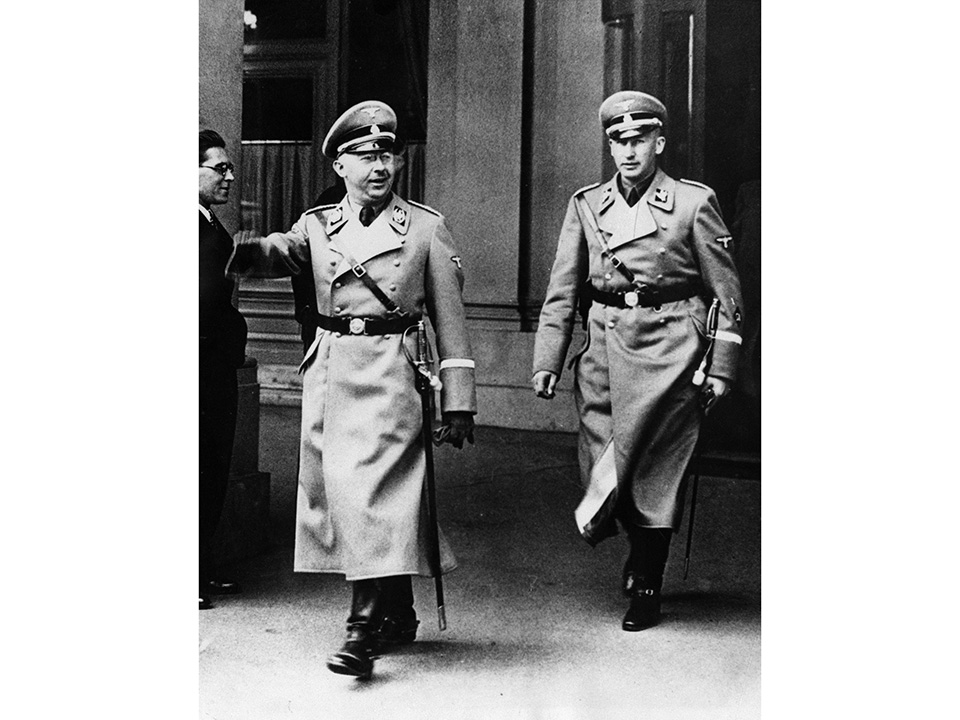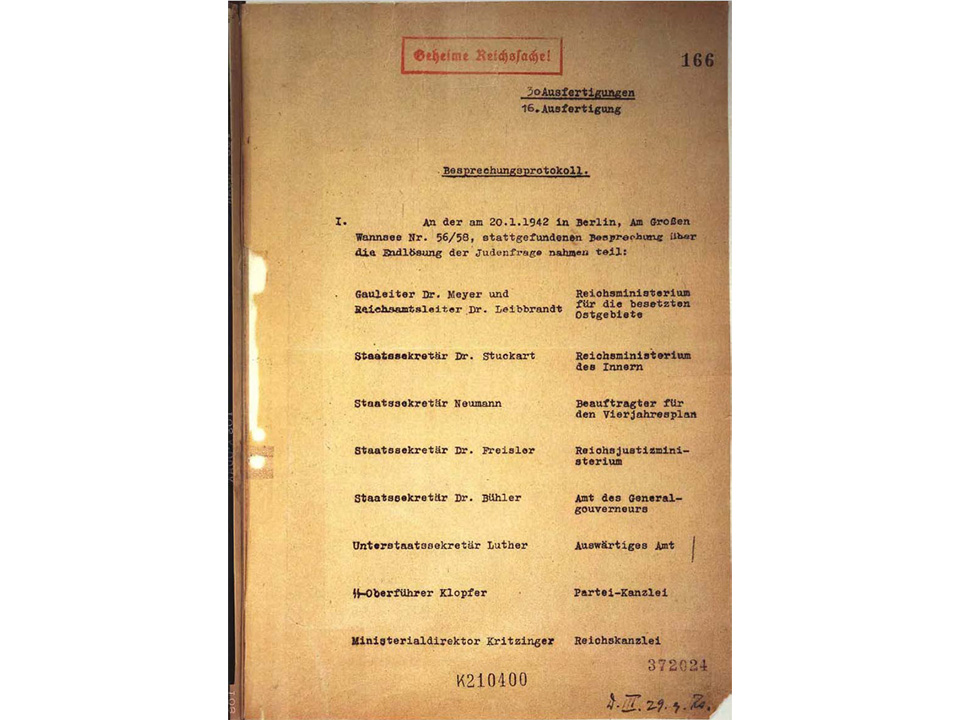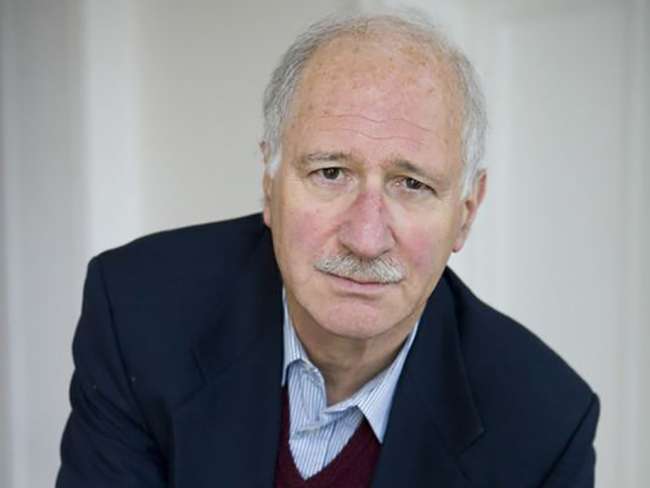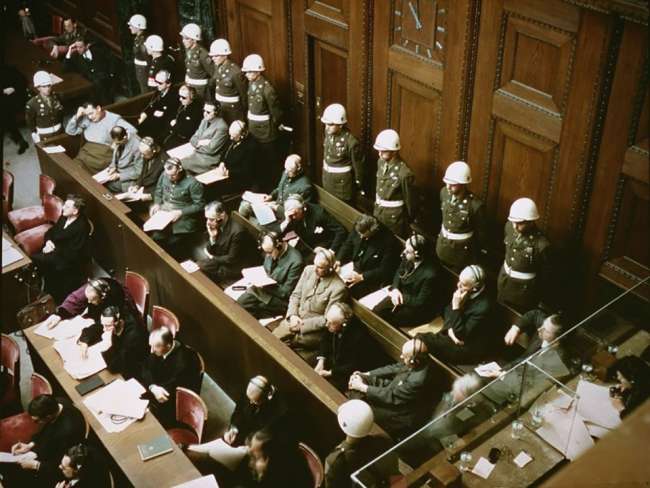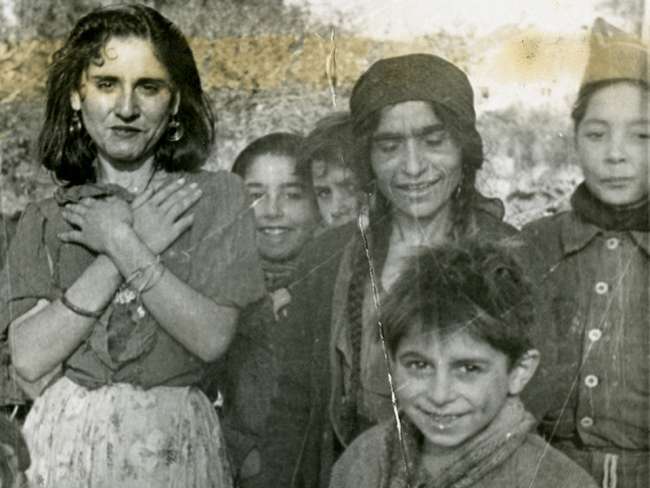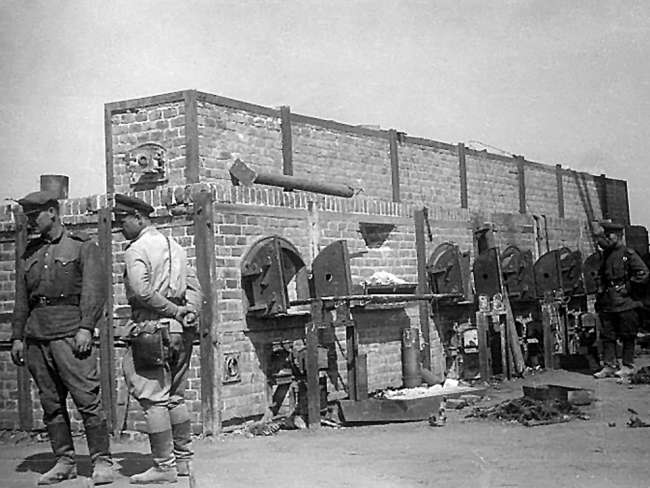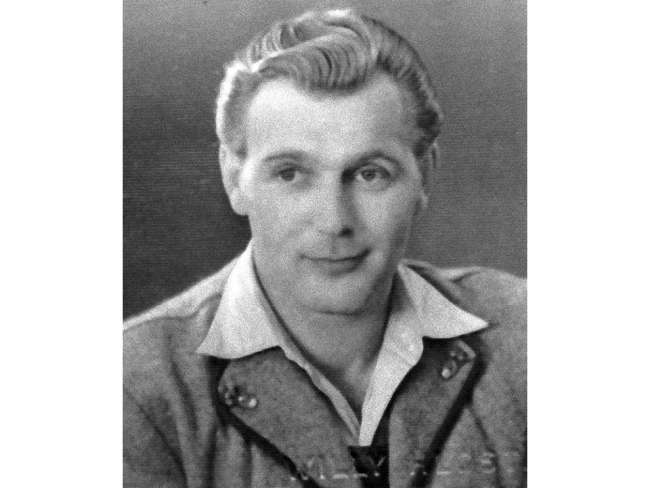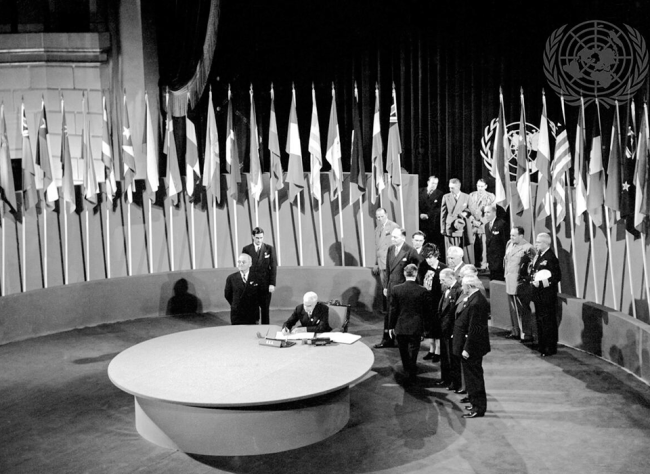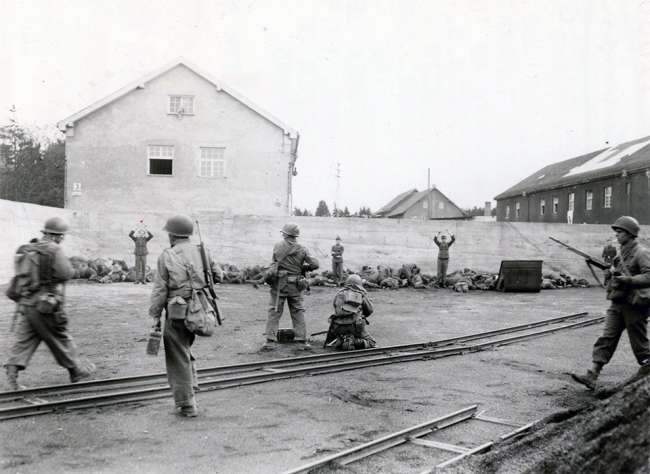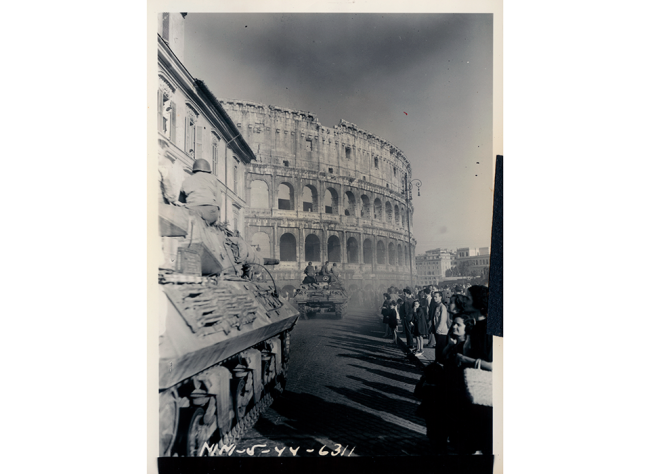Top Image: Entrance to the Memorial and Educational Site-House of the Wannsee Conference. Courtesy of Stephen and Irene Parris.
On the afternoon of Tuesday, January 20, 1942, Chief of Security Police and the SD, Reinhard Heydrich, telephoned his superior, Reichsführer-SS Heinrich Himmler. He had much to tell him. The long-planned conference had been a success. Described in a later summary (that came to be known as the Wannsee Protocol) as a “Conference on the Final Solution of the Jewish Question,” the gathering of dignitaries of the Nazi Party and German government had only just dispersed.
Students of the history of World War II are certainly familiar with high-level meetings, such as the conferences between Allied leaders at Tehran, Yalta, and Potsdam. What transpired at Am Grossen Wannsee No. 56/58 in Southwest Berlin that January day was as consequential as any of those meetings. There in an elegant villa used as a guest house by the nerve-center of the National Socialist terror system, the Reich Security Main Office (RSHA), and close to a beautiful lake, Nazi leaders coordinated the destruction of an entire people. A photograph of the entrance to the villa snapped and generously shared by my friends, Stephen and Irene Parris, both educators, captures the picturesque quality of the place. Beauty and absolute horror commingled on its premises.
The meeting kicked off around noon on January 20. Fourteen men sat at the table with Heydrich. They came from Nazi Party agencies, the SS and police apparatus, civilian occupation administration, and government ministries. Among them was Heydrich’s trusted subordinate, Adolf Eichmann, since 1938 the SD and then RSHA’s “expert” on forced emigration of Jews. Eichmann, who during his trial in Jerusalem almost 20 years later downplayed his role at Wannsee, supervised the work of the stenographer keeping the minutes.
Originally, Heydrich had intended to hold the conference on December 9, 1941. However, Imperial Japan’s assault on Pearl Harbor, American entry into the conflict, and then Hitler’s decision to declare war on the United States delayed the meeting for several weeks.
First, it must be emphasized what did not happen at Wannsee. Although we still do not know its precise date, Adolf Hitler’s order to murder every human being of Jewish descent across the European continent had already been enacted. Systematic mass shooting of Soviet Jews had begun in the summer of 1941, with some 900,000 victims already murdered by the end of 1941. German Jews deported to Riga, Latvia, had been massacred in October 1941. Operations started in early December 1941 at the Chelmno extermination center where the SS asphyxiated Polish Jews in specially-modified gas vans. This sequence of monstrosities provided “lessons” for Heydrich about possible courses of action. Second, the representatives of party and state did not collectively plan a genocide. As a group, they enjoyed far less agency than their titles might indicate.
Right at the outset Heydrich declared that the “Final Solution of the Jewish Question”—a phrase that had been in use but had not yet acquired the horrid meaning we recognize—was the sole purview of the SS. And he—Heydrich—was the plenipotentiary entrusted by Hermann Göring to resolve it. The role of the ministries and organizations represented at the table was thus one of support. Then Heydrich reviewed the history of the Third Reich’s chief policy with respect to Jews: compelling them to emigrate from Germany, Austria, and the Czech territories. This approach, which always had its own difficulties, said Heydrich, had been definitively abandoned. He reminded the attendees that Himmler had prohibited further Jewish emigration in the fall of 1941.
Ominously, Heydrich next spoke of “looming possibilities in the East” opened up by German military conquests. “Emigration has now been replaced by evacuation of the Jews to the East.” Here in this one sentence Heydrich disclosed a new, decisive—and genocidal—phase in the Nazi dictatorship’s prosecution of World War II as a race war.
Even with all the advantages of hindsight, the intent behind all this talk does not cease to terrify. Heydrich declared that “11 million Jews will be involved in the final solution of the European Jewish question.” He showcased statistics which purported to capture the total number of Jews in countries occupied or invaded by Nazi Germany. Similarly, he exhibited information about Jewish communities in nations allied to the Reich, like Fascist Italy and Marshal Antonescu’s Romania, as well as satellite and collaborator regimes such as Admiral Horthy’s Hungary and Slovakia under Father Tiso. The 55,000 Jews in European Turkey were also listed. Heydrich even had the small Jewish population of Ireland in view.
This plan entailed combing Europe from West to East. At this point, Heydrich prioritized the removal of German, Austrian, and Czech Jews. Other Jewish communities would be swept up later in this massive operation of racial expurgation. Transit ghettos would function as temporary waystations before the victims were transported to their final, terrible destinations further East.
Heydrich singled out Theresienstadt, a transit ghetto near Prague, for special use. Jews who were over the age of 65, had been decorated for their service in World War I, or bore injuries or disabilities from combat in that conflict would be sent there. These would be the only exceptions.
So what did Heydrich reveal to his audience about the fate of the deported Jews? With emigration now discarded, Heydrich fleshed out what he intended by “looming possibilities in the East.” Jews were to do forced labor. Separated by sex and massed in large labor units, they would be compelled to build roads and work in other construction tasks. Heydrich made it very clear, though, that the future for European Jews was not a perpetuity of unfree labor. No, this was to be annihilation through labor, where “a large number of them will undoubtedly drop out by natural reduction.” He warned that “suitable treatment” would have to be administered to the “most resistant segments” of the Jewish population. The latter could not be permitted to form “germ cells” of an anti-Nazi opposition. “Suitable treatment,” unsurprisingly, remained vague in the Protocol.
On the question of Jewish labor for Germany, Heydrich had to confront the question of wartime exigencies. Some Jewish workers had skills that were truly indispensable. As Heydrich biographer Robert Gerwarth states, “Even Heydrich could not ignore wartime economic needs at a time when Nazi Germany was confronted with manpower shortages on a dangerous scale. He attempted to balance recognition of current labor scarcities with a desire to eliminate all Jews, although his determination to kill all ‘resilient’ surviving Jewish laborers shows that he privileged ideology over economic concerns and military necessities.”
Things became more contentious over what was to be done with Mischlinge, the Nazi term for persons of mixed Aryan and Jewish descent codified by the Nuremberg Laws of 1935. Heydrich laid out guidelines for who among them was to be evacuated and who might be exempted. He encountered some opposition that his proposals would needlessly complicate matters with these individuals, many of whom had married full-blooded Aryans and had families with them. The participants weighed sterilization as an option. For the remainder of the war, though, the Nazi dictatorship never definitively settled on a policy for Mischlinge—a bureaucratic failure which saved many lives.
Near the end of the discussion, the Wannsee Protocol refers to "different types of possible solutions" (verschiedene Arten der Lösungsmöglichkeiten) for the “Jewish Question.” Apparently, Heydrich instructed Eichmann that no specifics of the methods of killing be given. To anyone with eyes to see, though, it was obvious what was meant. The transition from mass shooting to gassing was already underway.
The Wannsee Conference lasted only 90 minutes. After the meeting concluded, Heydrich and Heinrich Müller, head of the Gestapo, asked Eichmann to join them for brandy and a cigarette. The three genocidists sat around the fireplace in the villa, smoking and drinking for a short while. As Eichmann later recounted, it was rare indeed to witness the austere Heydrich enjoying alcohol and a smoke. Yet for the Chief of Security Police and the SD there was much to celebrate. The gloating Heydrich realized that a system for destroying the entire Jewish people was settled. And it would operate under his leadership. He would report only to Himmler, who was responsible only to Hitler himself. Eichmann would manage this “Final Solution.” The assassination of Heydrich by Czech resistance fighters less than six months later did not halt what had been arranged at Wannsee.
There were some 30 copies of the 15-page Wannsee Protocol distributed within the various offices of the RSHA and the government ministries. Put together by Eichmann and marked “Secret Reich Matter,” Heydrich altered this document several times before it was circulated. Most of these copies disappeared during the war. Thankfully, one was discovered in 1947 by the German-born lawyer, Robert Kempner, who had been expelled by the Nazis in the mid-1930s because of his Jewish origins. A translation of this copy, No. 16, which I have used for this article, is available at the website of the Memorial and Educational Site House of the Wannsee Conference. Years later, in 1965, it was historian Joseph Wulf, a survivor of Auschwitz, who started the push to preserve the villa as a site of remembrance.
First page of Copy 16 of the Wannsee Protocol-Marked “Secret Reich Matter.” Courtesy of the Museum and Educational Site-House of the Wannsee Conference.
From Kempner’s find, we have learned so much. Due to the cooperation of the party and state agencies and ministries with Heydrich and the SS, genocide became a national project for Nazi Germany. Henceforth, the Hitler regime became the exemplar of radical evil in modern history. The names of the 15 men who attended the Wannsee Conference are reproduced here to ensure that they are never forgotten:
SS Obergruppenführer Reinhard Heydrich Reich Security Main Office
SS Gruppenführer Heinrich Müller Reich Security Main Office
SS Obersturmbannführer Adolf Eichmann Reich Security Main Office
SS Oberführer Dr. Eberhard Schöngarth Security Police and SD
SS Sturmbannführer Dr. Rudolf Lange Security Police and SD
SS Gruppenführer Otto Hofmann Race and Settlement Main Office
Gauleiter Dr. Alfred Meyer Reich Ministry for the Occupied Eastern Territories
Reich Office Director Dr. Georg Leibbrandt Reich Ministry for the Occupied Eastern Territories
SS Oberführer Gerhard Klopfer Nazi Party Chancellery
Undersecretary of State Martin Luther Foreign Office
State Secretary Dr. Josef Bühler Office of the Government-General
State Secretary Dr. Roland Freisler Reich Ministry of Justice
State Secretary Erich Neumann Plenipotentiary of the Office for the Four-Year Plan
Permanent Secretary Wilhelm Kritzinger Reich Chancellery
State Secretary Dr. Wilhelm Stuckart Reich Ministry of the Interior
Recommended Reading:
Gerwarth, Robert. Hitler’s Hangman: The Life of Heydrich. New Haven: Yale University Press, 2012.
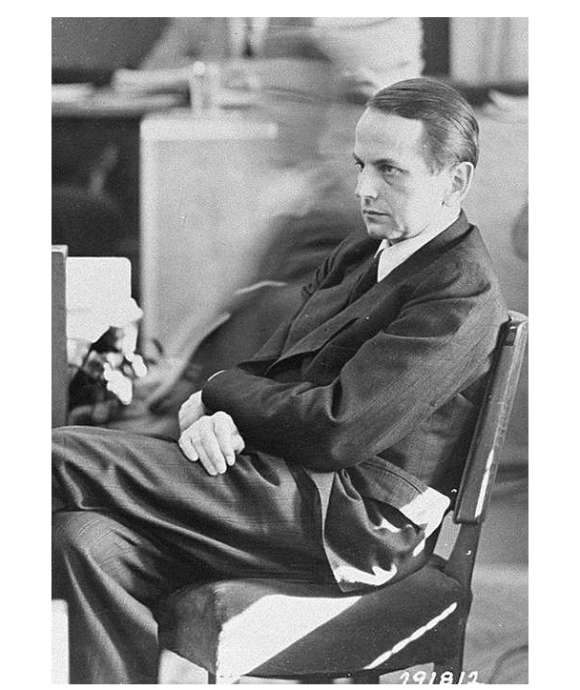
Otto Ohlendorf, Einsatzgruppe D, and the ‘Holocaust by Bullets’
As the leader of Einsatzgruppe D, Otto Ohlendorf was responsible for the murder of 90,000 Soviet Jews, Roma, and Communists.
Jason Dawsey, PhD
Jason Dawsey, PhD, is ASU WWII Studies Consultant in the Jenny Craig Institute for the Study of War and Democracy.
Cite this article:
MLA Citation:
APA Citation:
Chicago Style Citation:
